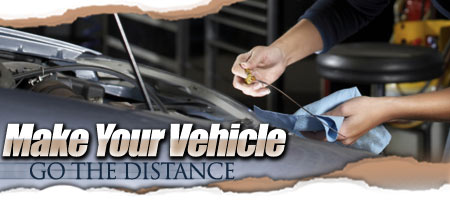
Make Your Vehicle Go the Distance
by
Kyle Busch
If
you are on a tight budget, or even on an unlimited budget, you know how important
it is to make the most of what you have.
The following are some tips
that will help you to get more miles out of your vehicle.
 |
Keep track of your mileage |
1. First, consider, does your vehicle actually have the ability to run many miles
without incurring costly repairs? Find out by visiting a public library to consult
the frequency-of-repair information in the April magazine issue of Consumer Reports.
If your vehicle has a poor repair history, consider buying a vehicle that has
better ratings and fuel efficiency.
If you want to extend the life of
your vehicle, at the beginning of each month, have the engine oil level checked
to make certain that it is at the full-level mark on the dipstick. Buying
two quarts of oil that are on sale and keeping it in the trunk, will enable you
to avoid getting stuck paying three times what the oil should cost. Be certain
to only use the type of oil and other fluids as specified in the vehicle owner's
manual.
2. Every three months (more
often, however, if specified by your vehicle owner's manual) and prior to leaving
for and upon returning from a trip, check (or have a service station attendant
check) the tire pressure and the other
fluids that include:
Why
is it important to keep the fluids at their full-level marks? The fluids lubricate
moving parts to reduce fiction, heat, and wear. Therefore, they are the single
most important factor for extending the life of a vehicle.
3. If you drive 6,000 miles or less per year, have the engine oil and oil filter
changed at the beginning of spring and near the end of fall. If you drive 10,000
or more miles per year, have the engine oil and oil filter changed every 3,000
to 3,500 miles or about every four months. An easy way to remember oil changes
is to mark a new calendar at the beginning of a year with "oil change"
reminders (i.e., May and November or April, July, and October). Service
stations usually run specials on oil changes (i.e., $10.99 - $13.99). However,
make certain that the station is reputable. Some stations have been known to skip
changing the oil or to do part of the job by changing the oil but not the
oil filter. To help make certain that the oil filter was in fact replaced, use
a black marker to put an X on the new oil filter after an oil change. When the next oil change has been completed, the newly installed
filter should not include an X.
4. Prior to winter, have a service station attendant check the antifreeze in the clear plastic coolant bottle with a hydrometer (a device that takes a sample of antifreeze and specifies how cold the temperature can become before the antifreeze freezes). The antifreeze should be able to withstand (i.e., not freeze) temperatures of at least 30 degrees "below the coldest" winter temperature. If the antifreeze is too weak, have additional antifreeze added to the coolant bottle.
Purchase the type of antifreeze as specified in the vehicle owner's manual (i.e., usually a type that is suitable for "aluminum and all types of metals" that are used today's engines). It important to avoid frozen antifreeze because it can crack an engine's block which could result in possibly thousands of dollars for the repair.
5. If you drive about 6,000 miles or less per year, have the engine air filter changed once every two years. If you drive over 10,000 miles per year, have the engine air filter changed once a year in the spring. Many discount stores
regularly have sales on air filters.
6. In the spring and in the fall give the vehicle a thorough wash, tar removal, and wax. When washing the vehicle in-between the seasonal waxes, use a car wash product that is safe for clear coat and waxed finishes.
7. Basic vehicle maintenance is an ongoing process. The secret to making it easy and keeping a vehicle looking great involves two components. First, maintaining regular vehicle involvement and second, only doing a little at a time. Each week throughout the year (in addition to the maintenance suggested above) take about 10-15 minutes to focus on a small aspect of the vehicle (i.e., wash the windows-week one, vacuum the carpet-week two, Armor All the dash and the door panels-week three, etc). After about three months, one of the "small jobs" will need to be repeated. However, the vehicle will never be in rough shape. Doing a small but thorough job on one specific aspect of the vehicle each week, requires very little time or energy. Having a vehicle that continually looks greatmakes it worthwhile.
The tips provided above are the most basic maintenance requirements that will help your vehicle to run longer. Be certain to reference the vehicle owner's manual for any additional maintenance required on your vehicle.
Basic vehicle maintenance involves a minimal investment of time and money, but it will provide major benefits in vehicle performance and lower repair costs. Additionally, your vehicle will be in better condition when it becomes time to sell.
Kyle Busch is the author of Drive the Best for the Price: How to Buy a Used Automobile, Sport-Utility Vehicle, or Minivan and Save Money. He has over 300,000 miles on his 1986 Volkswagen Jetta - a used vehicle that he bought in 1991 for $2,600. For more information about the book, call:1 800 839-8640 or visit: www.drivethebestbook.com. The web site accepts readers' transportation questions. |